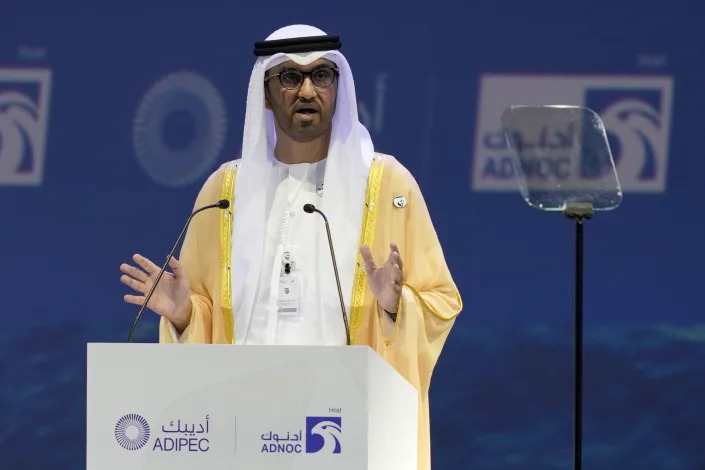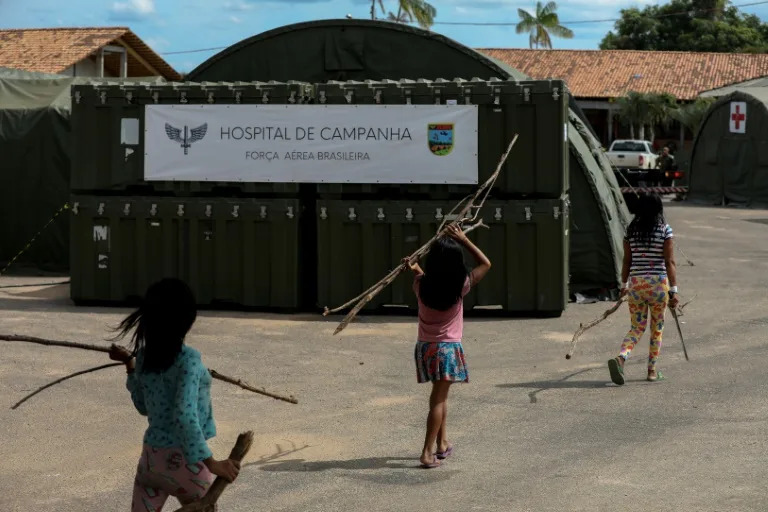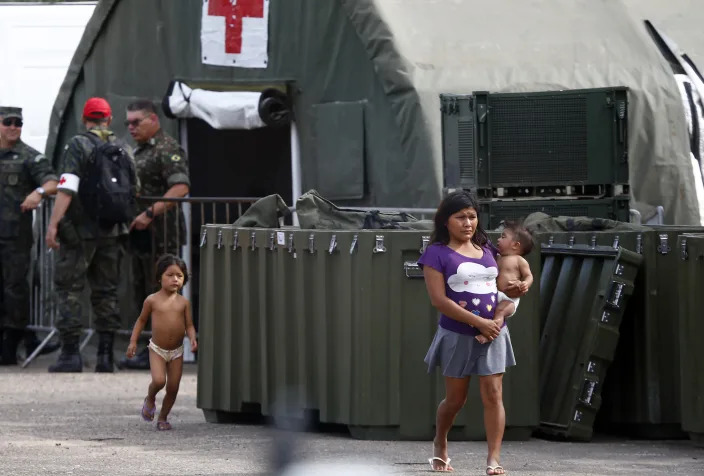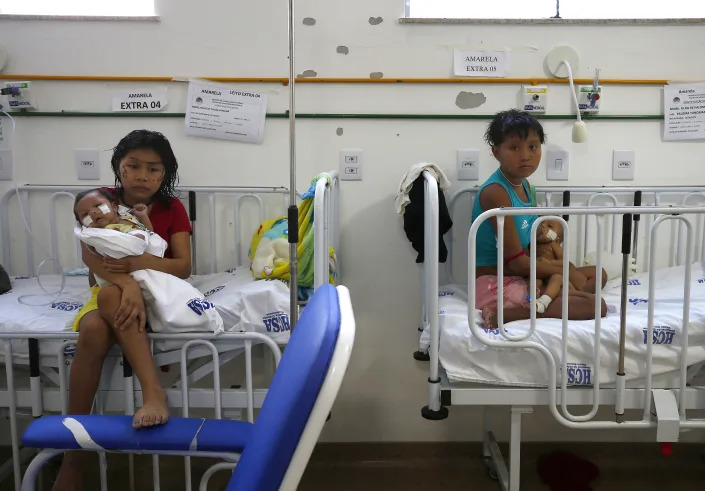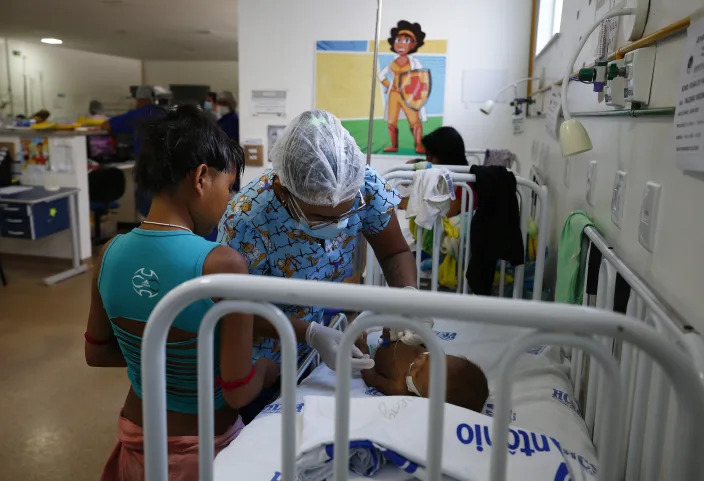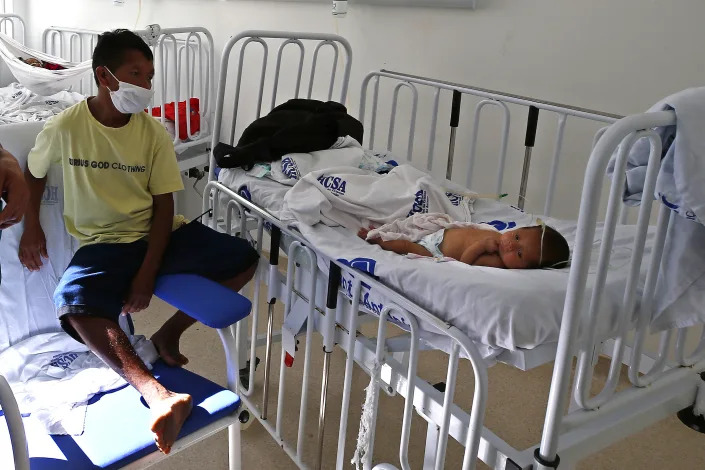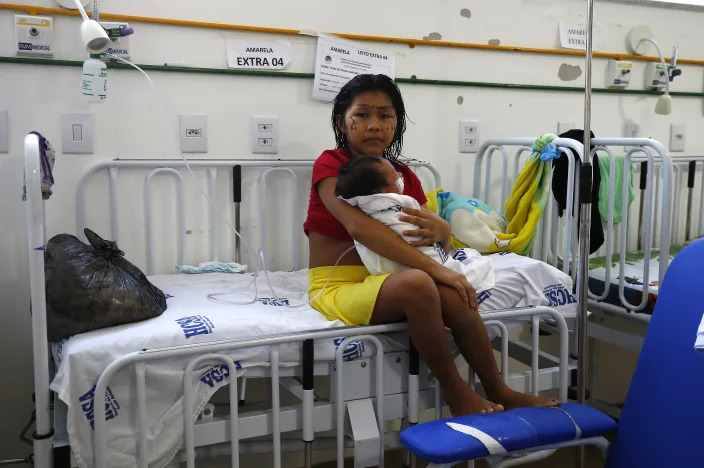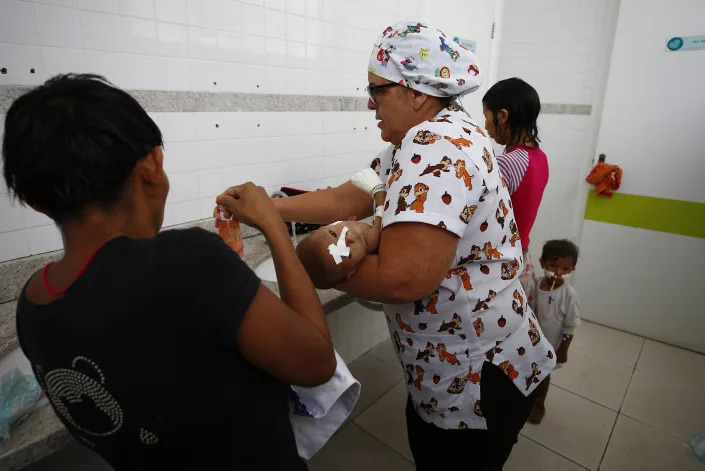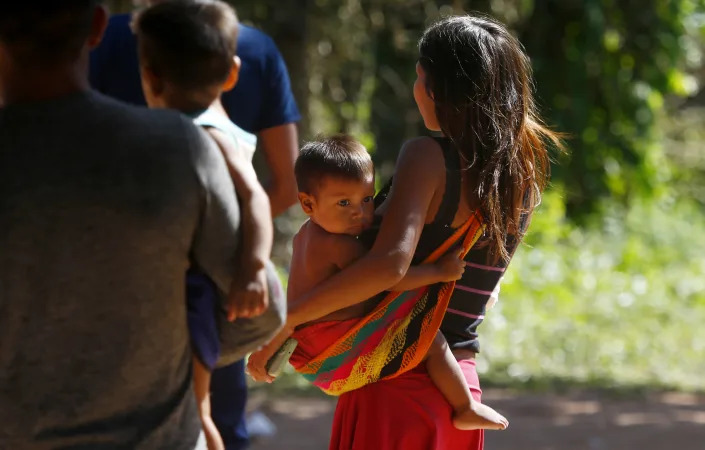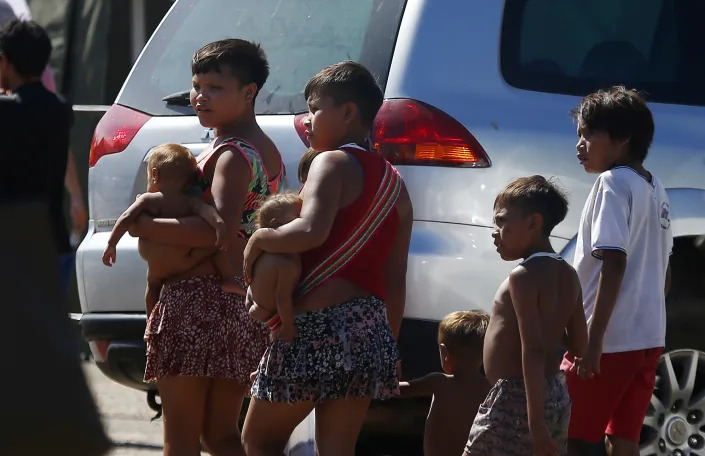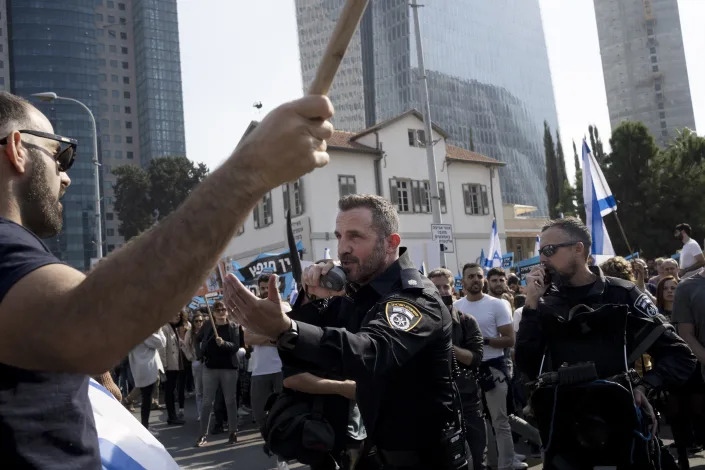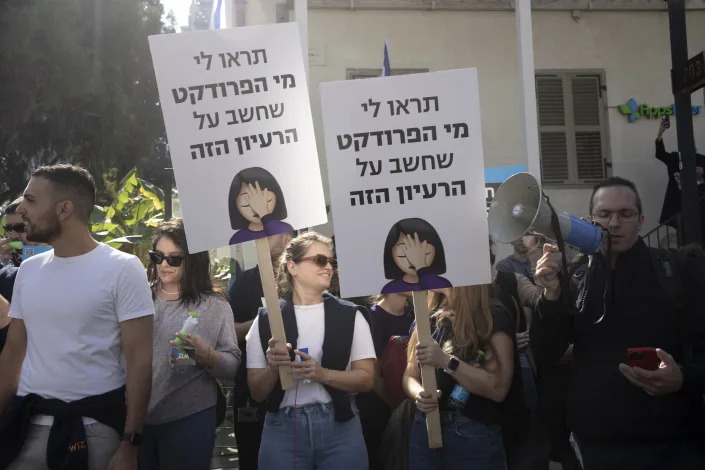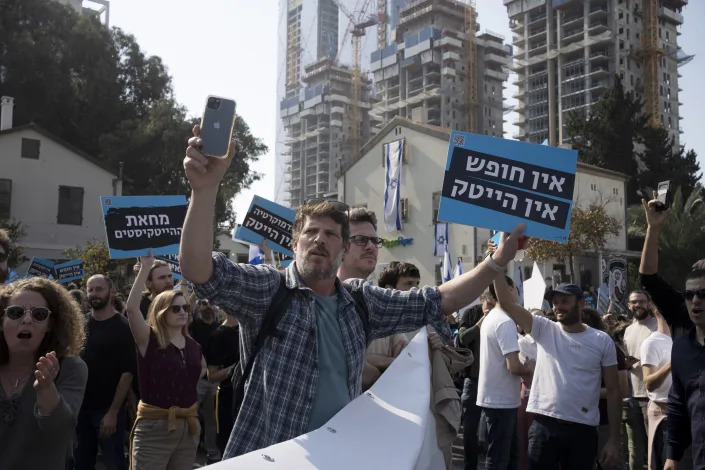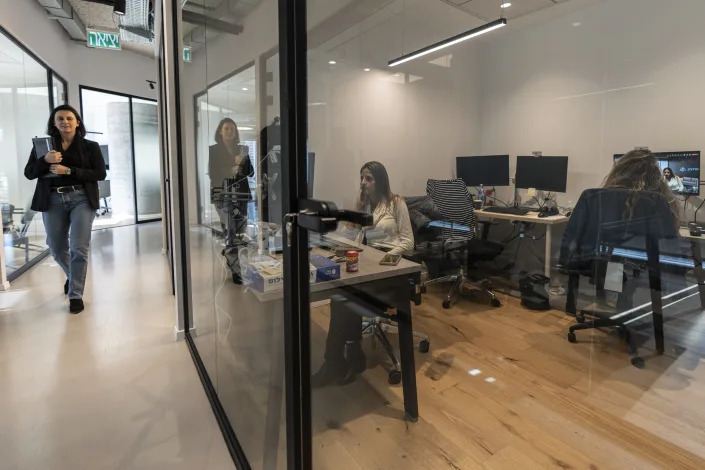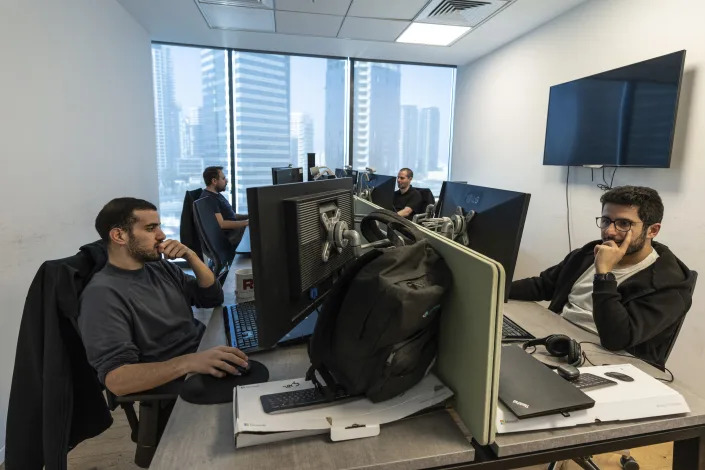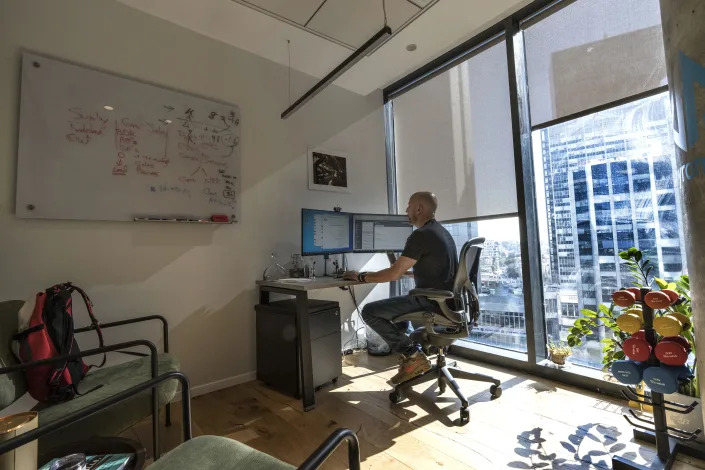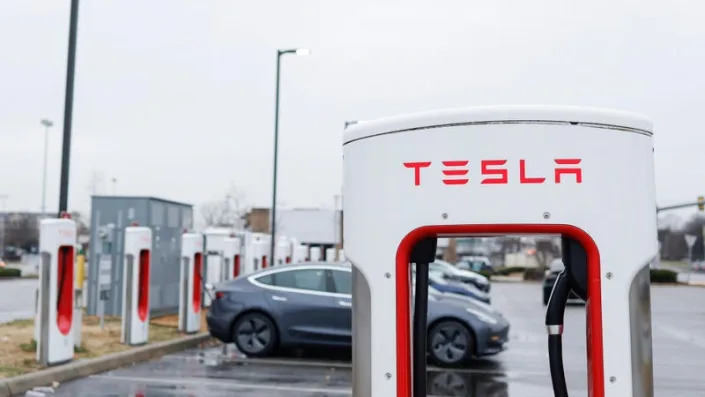Broadly unpopular with Arizonans, the independent lawmaker faces the biggest challenge of her political career.
Andrew Romano and Christopher Wilson
Wed, January 25, 2023
Sen. Kyrsten Sinema on Capitol Hill last August. (Michael Reynolds/EPA-EFE/Shutterstock)
There’s no shortage of Democratic senators in danger of losing their seats in 2024. Joe Manchin in ruby-red West Virginia. Jon Tester in solidly Republican Montana. Sherrod Brown in ever-more-conservative Ohio. And their colleagues in Wisconsin, Pennsylvania, Nevada and Michigan — four of the purplest places on the map.
But if the latest polls are to be believed, no Senate incumbent is in as much trouble as Arizona’s Kyrsten Sinema.
On Monday, Democratic Rep. Ruben Gallego of Phoenix launched his own bid for Sinema’s seat, setting up what could become the most fascinating and dramatic Senate brawl of 2024.
“I have been deeply humbled by the encouragement I have received from the people of Arizona, and today I am answering the call to serve,” he said in a statement.
The following day, his team announced that it had already raised over $1 million from more than 27,000 donations, surpassing in eight hours the Arizona record for the most individual donations in a campaign’s first day.
Rep. Ruben Gallego, D-Ariz. (Michael Brochstein/SOPA Images/Shutterstock)
On paper, someone like Sinema, a trailblazing centrist in a closely divided state, might seem relatively safe. Yet after years spent alienating progressives and blocking major parts of President Biden’s agenda, Sinema quit the Democratic Party in December and reregistered as an independent.
By doing so, she has now put herself at dire risk of losing reelection next year. That’s because while someone like Manchin could very well lose in West Virginia, he’ll still get 40% of the vote at the very least. Sinema, meanwhile, has a much lower floor and could theoretically limp across the finish line with less than half that.
It was clear to Arizona political observers when Sinema announced her switch that she was doing it (at least in part) to avoid a nomination challenge from the far more liberal Gallego, a longtime critic who led her by a staggering 58 percentage points (74% to 16%) among Democratic primary voters in a Data for Progress survey conducted last year.
By campaigning as an independent instead of a Democrat, Sinema would avoid a head-to-head primary contest with Gallego or another progressive, proceeding automatically to the general election.
The bet Sinema was making, analysts said, was that state and national Democrats would treat her like Bernie Sanders of Vermont and Angus King of Maine — the other independent senators who caucus with the party on Capitol Hill — and discourage any of their own from running to her left so as not to risk dividing the Democratic vote and “throwing” the race to a Republican.
Gallego’s entrance into the contest, however, makes it all but impossible for Democrats to rally around Sinema as they have with Sanders and King. And the likely result — a three-way contest with a Republican in the mix — is going to test Sinema like never before.
In December, Public Policy Polling released a survey conducted on Gallego’s behalf showing the Democratic congressman (40%) statistically tied with former GOP gubernatorial nominee (and possible future Senate candidate) Kari Lake (41%) — while Sinema (13%) trailed both Gallego and Lake by nearly 30 points.
Former Arizona GOP gubernatorial nominee Kari Lake in Phoenix in December. (Jim Urquhart/Reuters)
An even more recent survey by Blueprint Polling again found Lake (36%) and Gallego (32%) locked in a close battle, with Sinema (14%) far behind.
Such paltry numbers suggest that rather than uniting moderates behind her, Sinema’s prized independence may have left her without a natural constituency heading into 2024.
“Right now, the polls reflect our natural tendency towards party identification,” Robert Robb, a longtime columnist for the Arizona Republic and a former GOP political consultant, told Yahoo News. “And that’s a barrier that Sinema will have to overcome.”
A September AARP survey found that not only do Arizona Democrats now see their senator more unfavorably (57%) than favorably (37%), but so do clear majorities of every other imaginable demographic group — including Arizona Republicans, women, Latinos and independents.
Sinema’s best hope to stay in office, then, might be to use her seat in the Senate as a platform to rebrand herself not as a centrist Democrat but rather as a “truly independent voice for Arizona” and the real heir to “maverick” Arizona Sen. John McCain. Her latest gambit — a compromise package of both Republican and Democratic immigration reforms negotiated with GOP Sen. Thom Tillis of North Carolina — could help burnish that brand (in the unlikely event it survives Congress).
“Two years is a long time, and Sinema might be the most important senator in the country right now,” Arizona pollster and political consultant Paul Bentz told Yahoo News. “She’s getting a lot of attention because of that, and that gives her a lot of opportunity — opportunity to focus on getting things done in Washington, D.C., building a coalition and coming back to the state with excellent talking points to run on.”
Sinema speaking at the World Economic Forum in Davos, Switzerland, on Jan. 17. (Markus Schreiber/AP)
If the far-right Arizona GOP continues its self-defeating strategy of nominating divisive, radical figures (such as losing 2022 Senate candidate Blake Masters) and Gallego veers too far left on issues like immigration, Sinema would — in theory — have a chance to win over the bulk of voters who live somewhere in the middle.
“The conventional wisdom is that Sinema has no chance, and the only question is whether she takes more votes away from the Democrat or the Republican,” Robb said. “But if you look at her approval numbers, they’re in the 35% to 38% range, which is a pretty good base in a three-way race where 40% will probably win the seat. The challenge is keeping those people from defaulting back to partisan identification on Election Day.”
Meanwhile, the goal for Gallego — a Harvard-educated Marine combat veteran who was first elected in 2014 — is to splinter whatever centrist coalition Sinema tries to assemble.
“You already see Ruben in his announcement video using his humble beginnings and his military background to try to appeal to independent, unaffiliated voters,” explained Bentz. “The more he cuts into that vote while defending the Democratic base, the better his chances. He doesn’t even mention that he’s a Democrat.”
A member of the Congressional Progressive Caucus, Gallego had been attacking Sinema for months in advance of formally announcing his campaign. And his preferred line of attack — that Sinema isn’t insufficiently progressive but rather insufficiently populist — is designed to resonate even with Arizonans who don’t feel loyal to Democrats.
Gallego at a campaign event in Phoenix on Nov. 2, 2022. (Patrick T. Fallon/AFP via Getty Images)
“The problem isn’t that Sen. Sinema abandoned the Democratic Party, it’s that she’s abandoned Arizona,” Gallego said in Monday’s statement. “She’s repeatedly broken her promises and fought for the interests of Big Pharma and Wall Street at our expense.”
Going forward, Gallego will have no shortage of fodder for such attacks. Last year, for instance, Sinema single-handedly forced Democrats to alter the Inflation Reduction Act and strip out taxes on hedge funds and private equity firms in order to earn her critical vote, saving those companies an estimated $14 billion.
From 2017 to 2022, Sinema’s campaign received more than $6 million from the finance, insurance and real estate industries, according to the nonprofit research group OpenSecrets. She also raked in more money from payday lenders during the 2022 cycle than any other senator.
None of which is to say that Gallego, who represents the single bluest congressional district in Arizona, is the new frontrunner. “Except on some military and foreign policy issues, he’s a standard-issue strong liberal candidate,” said Robb. “And they do not fare well in Arizona in statewide elections. He fits his district. He does not fit the state.”
But the problem for Sinema is that she doesn’t just have to beat Gallego; she has to beat a Republican too. And it isn’t hard to imagine a MAGA candidate such as Lake joining with Gallego to slam Sinema for, say, hobnobbing with global elites at Davos in a white fur vest (which Sinema did last week).
The irony of Sinema’s plight is that Democratic Sen. Mark Kelly, her fellow Arizonan, has seemingly found a way to appeal to swing voters without offending the base at every turn — and last November he comfortably won reelection as a result.
Sen. Mark Kelly, D-Ariz. (Ross D. Franklin/AP)
Although Kelly has been a more reliable vote for Biden’s agenda than Sinema, several of his 2022 campaign ads described him as “working with Republicans” and “stand[ing] up to the left”; at one debate, he went so far as to describe some of Biden’s immigration decisions as “dumb.” Kelly also “helped sink one of Joe Biden’s labor nominees, pushed the president to open new drilling in the Gulf of Mexico and hammered the administration over lifting pandemic-era restrictions on the southern border,” according to Politico.
To be sure, Kelly’s Republican rival, Blake Masters, did himself no favors by touting the Unabomber’s political writings and blaming “Black people, frankly” for gun violence. But typically, the president’s party loses independents by double digits in midterm years. In contrast, the 2022 exit polls showed Kelly trouncing Masters among independents — who, at 40%, made up a larger share of Arizona’s electorate than Democrats (27%) or Republicans (33%) — by a remarkable 55% to 39% margin.
In 2024, Sinema will somehow have to perform even better than Kelly among independents, because Gallego’s bid will leave her with far less support on the left.
“Republicans are more likely to be solidified behind the Republican nominee, whereas we’ll see both Gallego and Sinema competing for Democrats and a lot of the independent audience,” Bentz told Yahoo News. “In fact, we did the math, and Sinema would need to win about 25% of Republicans, about 25% of Democrats and at least 60% of independents and unaffiliated voters to have a chance.”
In truth, Sinema would probably struggle to turn out progressives even if Gallego had passed on the race. The more she has refused to support ending — or even reforming — the 60-vote threshold created by the Senate’s legislative filibuster, the more Democrats have raged against her.
In January 2022, the Arizona Democratic Party voted to formally censure Sinema over her refusal to adjust the filibuster to pass new voting rights legislation. Polling that month showed her with a 19% approval rating among Arizona Democratic primary voters, versus 83% for Kelly and 80% for Biden.
Sinema in the Capitol on Dec. 13, 2022. (Bill Clark/CQ-Roll Call, Inc via Getty Images)
“We appreciate Senator Sinema’s leadership in passing the American Rescue Plan and the Bipartisan Infrastructure Law,” state party chair Raquel Terán said in a written statement at the time. “However, we are also here to advocate for our constituents and the ramifications of failing to pass federal legislation that protects their right to vote are too large and far-reaching.”
Emily’s List, an organization that supports female candidates who favor reproductive rights, released a statement the same month criticizing the senator for her pro-filibuster position. Previously the group had been Sinema’s biggest supporter, donating more than $400,000 to her successful 2018 Senate bid.
“Right now, Senator Sinema’s decision to reject the voices of allies, partners and constituents who believe the importance of voting rights outweighs that of an arcane process means she will find herself standing alone in the next election,” Laphonza Butler, the group’s president, said in a statement.
But regardless of whether Democrats officially abandon Sinema for Gallego — so far, national party leaders seem intent on neutrality — the risk of mutually assured destruction remains very real.
“Having a three-way race benefits Republicans in the state of Arizona,” Bentz said. “So while we saw Republicans struggle in the last statewide election — particularly those who were prone to denying the 2020 results, pledging fealty to Trump and on the extreme end of the abortion discussion — those problems will be less impactful in a contest against both Sinema and Gallego.
“We don’t know who the GOP will nominate, but I expect a spirited and very crowded primary,” he added. “This is going to be one of the best chances for Republicans to start winning again — if they can get their act together.”



